The landscape is unique among subject matter in its expanse, atmosphere, colour and light dynamics and its complexity. Landscape painters whether they are inspired by the urban or the natural world are irresistibly drawn to translate these aesthetic qualities into paint.
Artists have been painting landscapes since ancient times. Dating back to the fourth century, landscape painting in China was regarded as the highest form of painting and recognition of a spiritual element has long been understood in Asian art.
Li Cheng – Luxuriant Forest Distant peaks – Song Dynasty

In Western art the appreciation of landscape as a subject is relatively recent. Until the seventeenth century landscape was simply the backdrop for portrait, religious and history paintings. The classical landscape paintings of Claud Lorrain and Nicolas Poussin brought landscape to the fore but in a highly idealised way, evoking ‘arcadia’ and pastoral simplicity. At the same time Dutch landscape painting, epitomised by Jacob van Ruisdael, developed as a more naturalistic approach based on what was observed.
During the eighteenth century in Europe the growth of travel and the ‘Grand Tour’ encouraged an appreciation of the ‘picturesque’ together with sensitivity to the power of the ‘sublime’ and the transcendental power of nature. Romanticism, in the art of Blake, Constable and Turner, highlighted new interest in the expression of responses to and feelings about nature. In America the Hudson River School sought to capture the reverence and awe inspired by epic views like Niagara Falls and the Grand Canyon, unlike anything encountered in the old world.
The development of watercolours paved the way towards greater appreciation of landscape painting. Sketching and painting the countryside became an important ‘accomplishment’.
J.M.W. Turner – The Blue Rigi
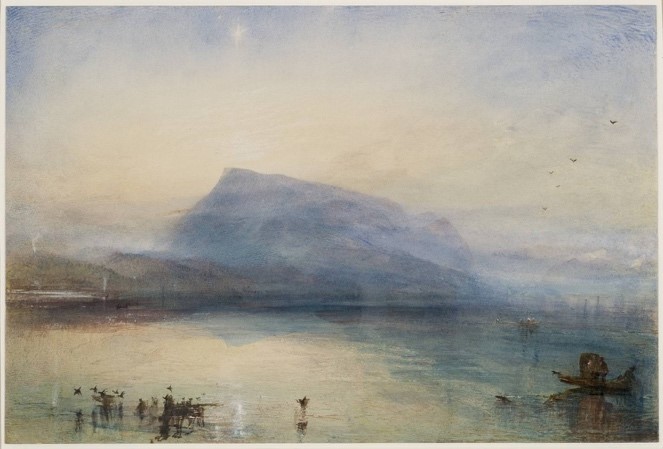
The watercolour paintings of Thomas Girtin and J.M.W.Turner transformed the way we look at landscape paintings, with realism giving way to aesthetic truth wonderfully exemplified by Turner’s The Blue Rigi.
In Germany Casper David Friedrich pre-empted abstract with his wonderful evocative paintings.
The Monk by the Sea – Casper David Friedrich
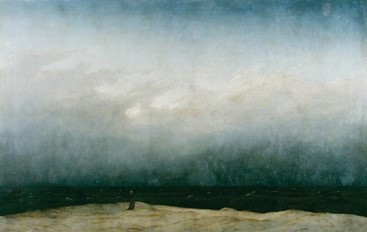
By the middle of the nineteenth century open-air painting in oils was an established practice, stimulated by the availability of oil paint in tubes and the expansion of the railways making the countryside more accessible. Artists maintained a distinction between sketches made outdoors and finished works painted in the studio. Bolder painting styles and a search for more realism was replacing representations of myth or allegory. Landscape artists Corot and Boudin led the way making oil sketches outdoors, ‘en plein air’.
The impressionists made a touchstone of open-air painting, emphasising the importance of direct observation, speed and spontaneity in order to capture the changing light across the seasons and times of day. Their art introduced a more subjective form of expression, with sketchy paint application, visible brushstrokes and inventive colour.
The Poplars at Giverney – Claude Monet
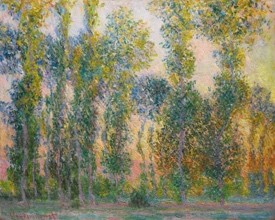
The twentieth century saw an explosion of different approaches to painting the landscape. The geometric landscapes of Cezanne, the expressive, vivid use of colour of the fauvists, the subconscious landscapes of the surrealists, which combined natural and imagined worlds and the steady influence of abstraction all encouraged ever more creative and subjective interpretations of the natural world.
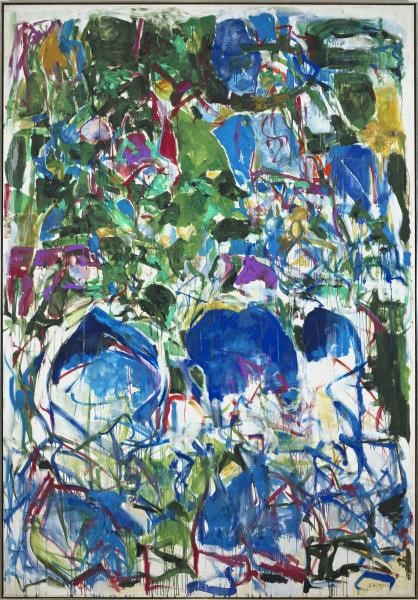
Joan Mitchell – My Landscape
In the twenty-first century postmodern art world the definition of landscape has expanded to include the urban and industrial landscape and embraces a wide range of media including photography, video, performance, installation and digital imagery. Land art, spearheaded by Richard Long, creates artworks directly within the landscape.
Richard Long – Earth Sky
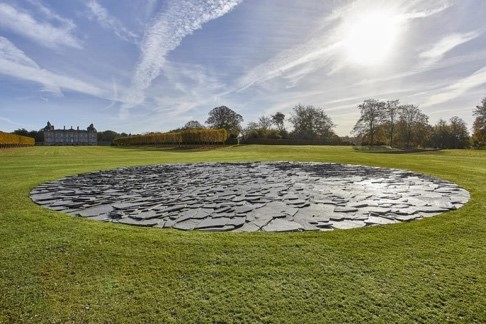
What all these artists have in common is a deep appreciation of the power and beauty of the landscape and the world as we experience it. Today, as human beings increasingly encroach on nature and with the reality and threat of climate change, our relationship with the landscape and our appreciation of the natural world becomes even more deeply important to us and increasingly nostalgic.
Abstract Landscapes
The world around us has so much space, so much colour and so much detail that it is impossible to capture it all. All landscape paintings are abstractions, the artist must simplify what is seen by framing the composition and eliminating unnecessary detail. So, the definition of abstraction in landscape painting is more about the intention of the artist – is the intention to recreate, as far as possible, the landscape as it is observed at a particular moment or is it about creating the essence or emotional power of the landscape as it is experienced, now or later as held in memories
Liz hauck – Holding Up the Sky
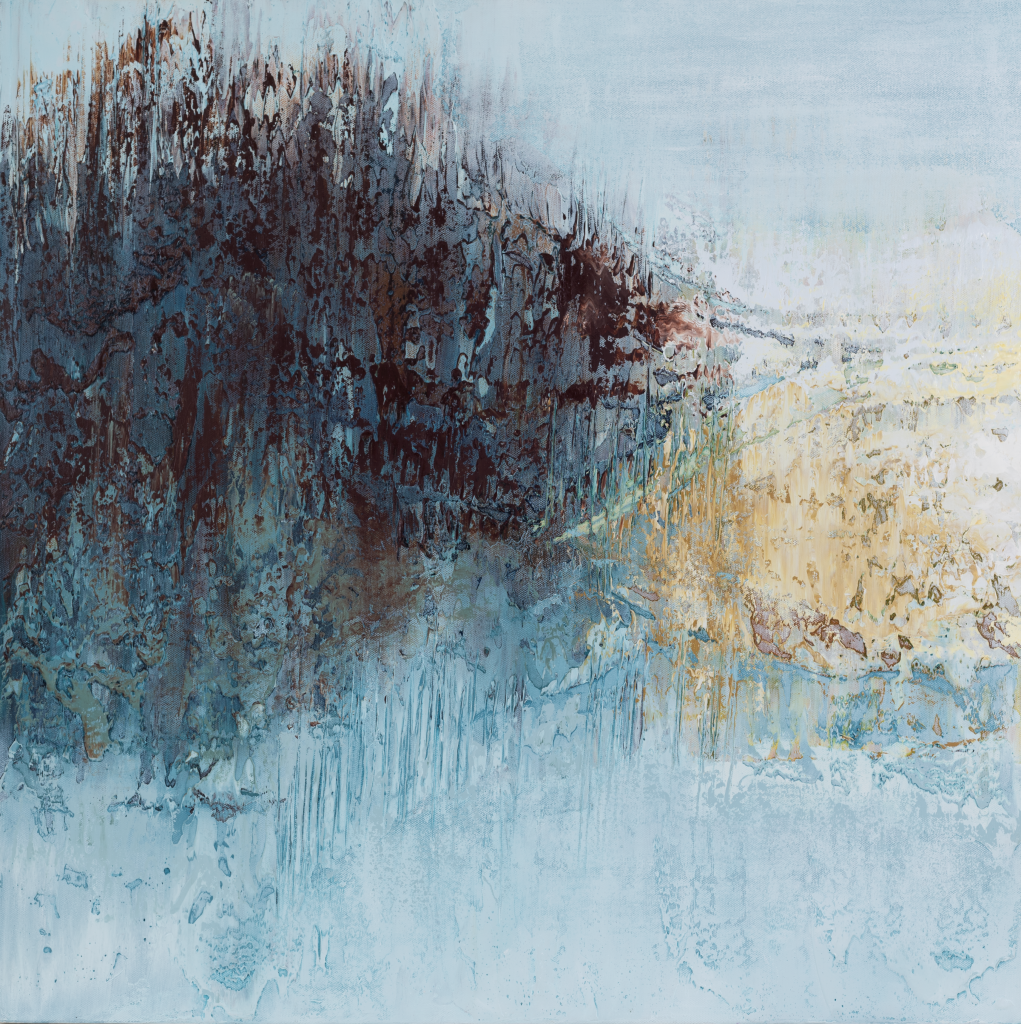
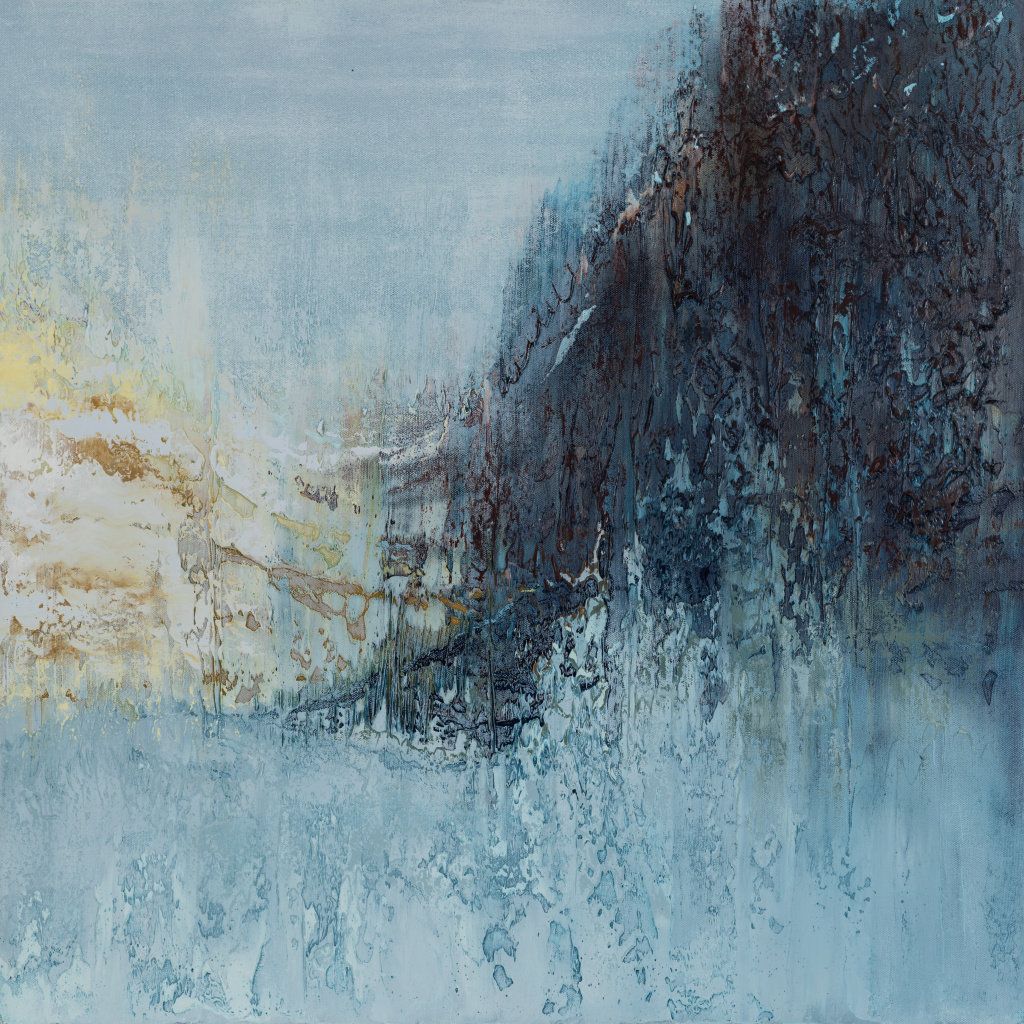
Contemporary landscape painter David Tress works in a traditional way, observing and sketching the landscape around his home in Wales then using his sketches to create the work in the studio. His paintings are far from traditional, using paper collage and paint in a highly expressive way whist still staying true to the appearance of a natural landscape.
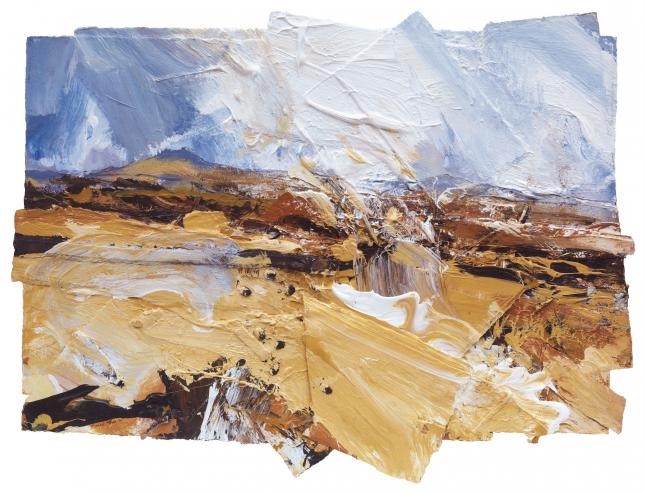
David Tress – Sometimes I think…
Landscape offers the artist an unlimited and constant source of inspiration – the changing colours of the seasons and across just one day as the light and atmospheric conditions change. So many colours, so many contrasting shapes, patterns and textures together with the inherent abstraction when nature is looked at close up, even more so when looked at microscopically.
Only the natural world has atmosphere, the illuminated dome of the sky, creating an envelope of light, which encompasses the landscape, draping everything with changing colours according to the time of day and the weather. The task for the artist is to recreate the effect of these light patterns on to the canvas using paint. Expressive landscape artist and colourist Wolf Khan attended the Hans Hoffman art school in New York in the 1950’s. His paintings using expressive colour achieve a wonderful luminosity, capturing the play of light in the landscape.

Wolf Khan – Yellow Overflow
If the intention is to create a recognisable illusion of a time and place based on observation, the primary challenge for an artist is to turn the two dimensions of the canvas into three dimensions; in other words, to recreate spatial depth in the contours and shapes and replicate the effect of the atmosphere. The artist must show the interplay of light and colour, simplifying what is seen, recreating naturalistic colour and the value relationships.
The art of painting representational landscapes lies in presenting an abstracted image. The more simplified the image is the more abstracted it becomes. The art is to create a naturalistic image, which acts as a convincing metaphor for what is literally perceived.
The landscape is so emotionally important to the human psyche that we perceive landscape paintings as metaphors for the way we feel and live our lives.
Michael Morgan – Undulating Path
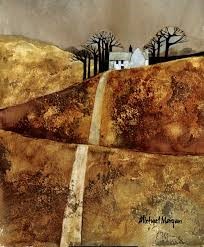
Michael Morgan’s delightful watercolours are based on detailed sketches and notes made while out in the countryside. His paintings are then created in his studio. Whilst he stays true to the sketches he has made and to this extent his work is representational, the image is highly abstracted and imprinted with his own personal style. In addition his paintings carry strong emotional messages, his landscapes acting as a simple but clear metaphor for the journey through life and the importance of home.
Using expressive colour rather than naturalistic colour takes a painting further towards abstraction. Those who choose to use expressive colour take a more subjective approach, not trying to be literal or to recreate the colours seen in nature. For this approach to be believable however, the ‘colour statement’ and the interplay of colour and value in the painting must still create a convincing, if not realistic, colour metaphor; a landscape for the viewer to experience in the imagination.
Liz Hauck – Somewhere in Between
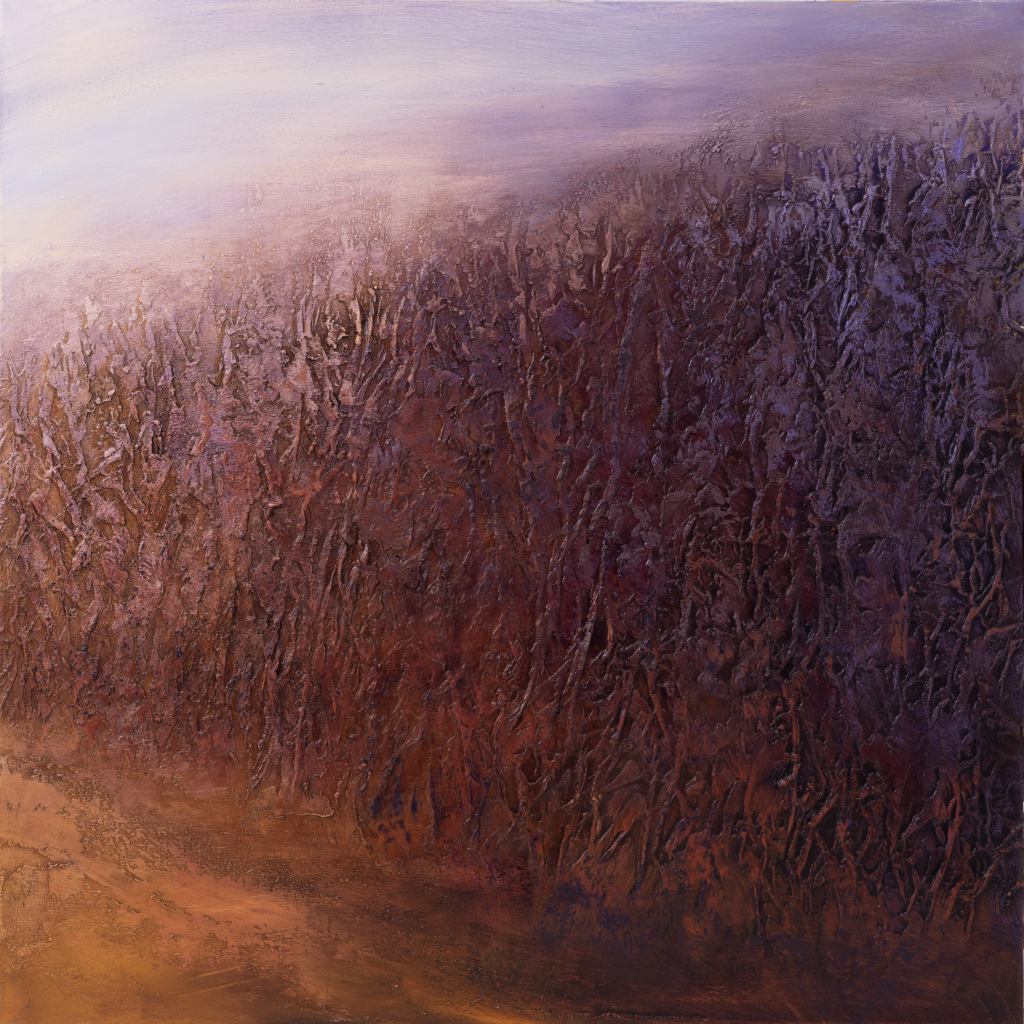
My abstract landscape paintings are painted from my imagination. Some may appear to be more realistic, others more abstracted – all are created from my memories and from my experience of landscapes in the UK and on trips abroad. To this extent they are perhaps better described as mindscapes.
I don’t tie myself down to naturalistic colour and the viewpoint I take varies; close up, frontal view, looking into the distance or a bird’s eye view. My inspirations and starting points are usually quite specific, usually something I have seen in the countryside close to home or on trips abroad. Although I don’t paint what I see literally, observation is very important to my art practice. Most often my camera is my sketch book but I also sketch and make comments on what I see, recording ideas for composition, shapes and colours.
Creating an image of the landscape as it is observed, however abstracted it may be, carries with it the idea of the artist as a detached, if appreciating and engaged observer. Stepping further into abstract landscape painting, the artist seeks to communicate the experience of and the power of the emotions they feel as part of the world around them. This is wonderfully articulated by Anselm Kiefer, whose powerful, imaginative landscape paintings, texturally enriched with soil and plants from the land, are designed to evoke the human history impregnated in the land.
Anselm Kiefer – The Bad Mothers
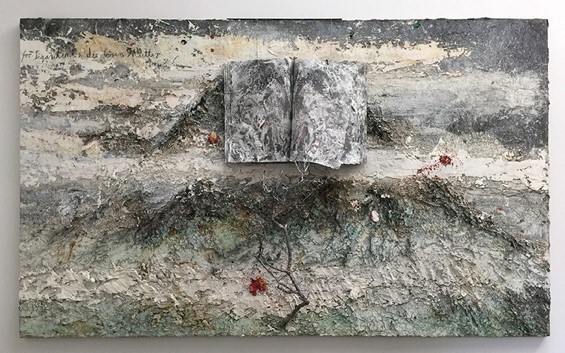
Whether the work is painted fast, painted ‘en plein air’ or created in the studio, whether it is painted from observation or from imagination, whether it is naturalistic or creates a ‘fantasy’ landscape, the essence of landscape painting is that it has the power to evoke our experience of and our wonder in the world around us.